University Economics Assignment: ECON6000/ECON6002 Module 1 & 2
VerifiedAdded on 2022/09/29
|10
|1308
|31
Homework Assignment
AI Summary
This economics assignment solution addresses key concepts from modules 1 and 2 of an economics course. Module 1 explores the relationship between income and demand, differentiating between normal and inferior goods, and analyzes shifts in the demand curve. It also explains the Production Possibility Frontier (PPF), its underlying assumptions, and the concept of opportunity cost. Module 2 delves into profit analysis, distinguishing between accounting and economic profit and their implications for business decisions. Furthermore, it examines negative externalities using the example of older vehicles and discusses the need for government intervention to achieve social efficiency. The solution provides figures and diagrams to illustrate the economic concepts discussed, along with references to relevant literature.
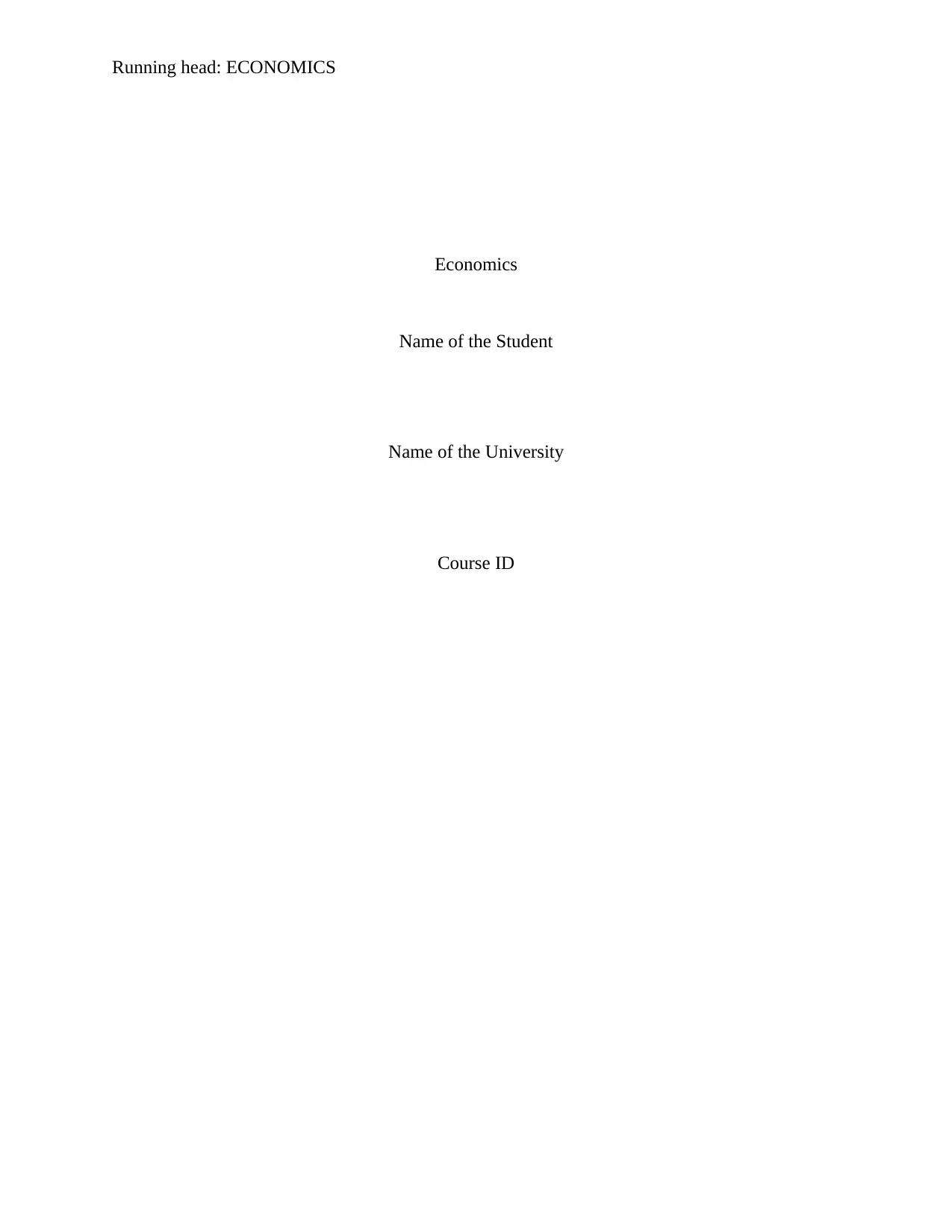
Running head: ECONOMICS
Economics
Name of the Student
Name of the University
Course ID
Economics
Name of the Student
Name of the University
Course ID
Paraphrase This Document
Need a fresh take? Get an instant paraphrase of this document with our AI Paraphraser
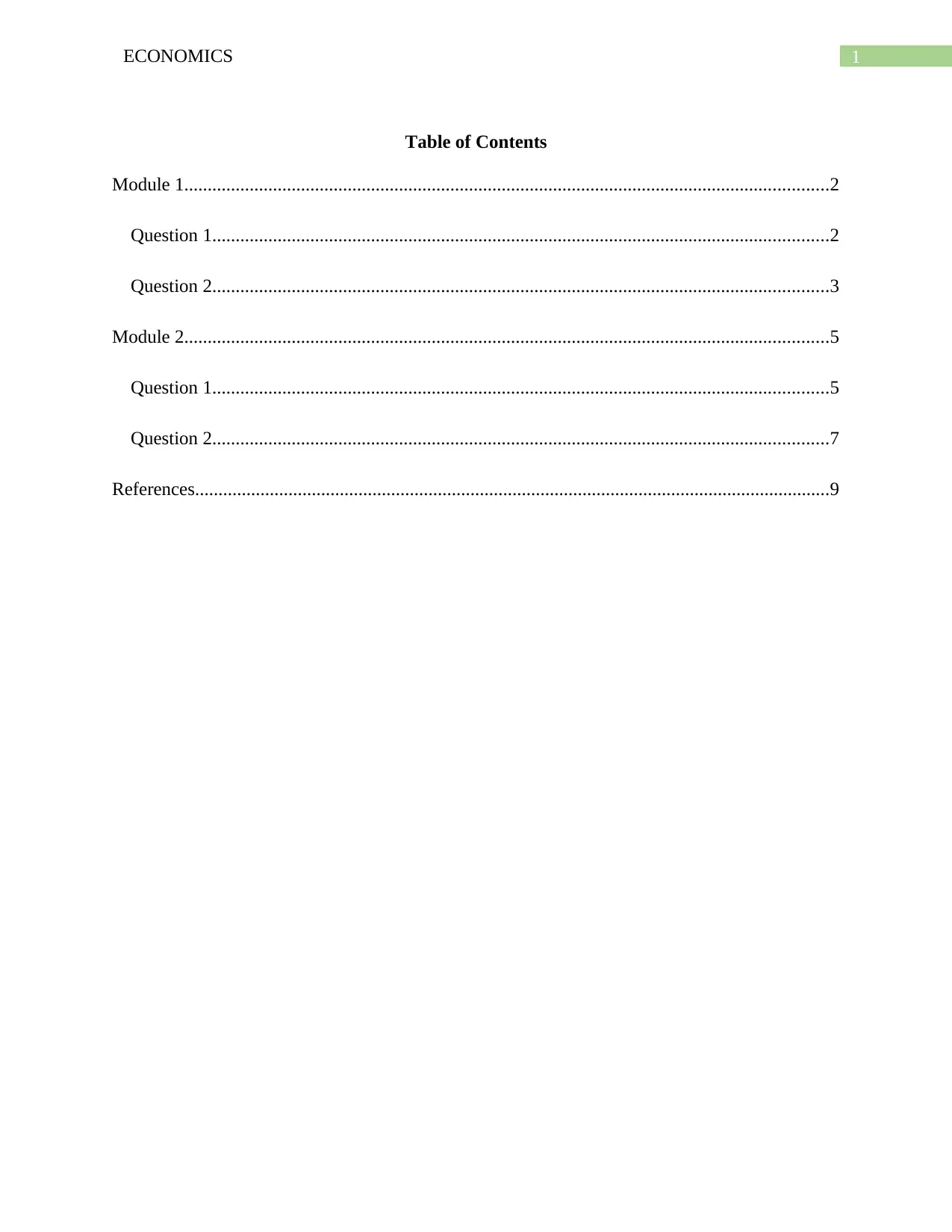
1ECONOMICS
Table of Contents
Module 1..........................................................................................................................................2
Question 1....................................................................................................................................2
Question 2....................................................................................................................................3
Module 2..........................................................................................................................................5
Question 1....................................................................................................................................5
Question 2....................................................................................................................................7
References........................................................................................................................................9
Table of Contents
Module 1..........................................................................................................................................2
Question 1....................................................................................................................................2
Question 2....................................................................................................................................3
Module 2..........................................................................................................................................5
Question 1....................................................................................................................................5
Question 2....................................................................................................................................7
References........................................................................................................................................9
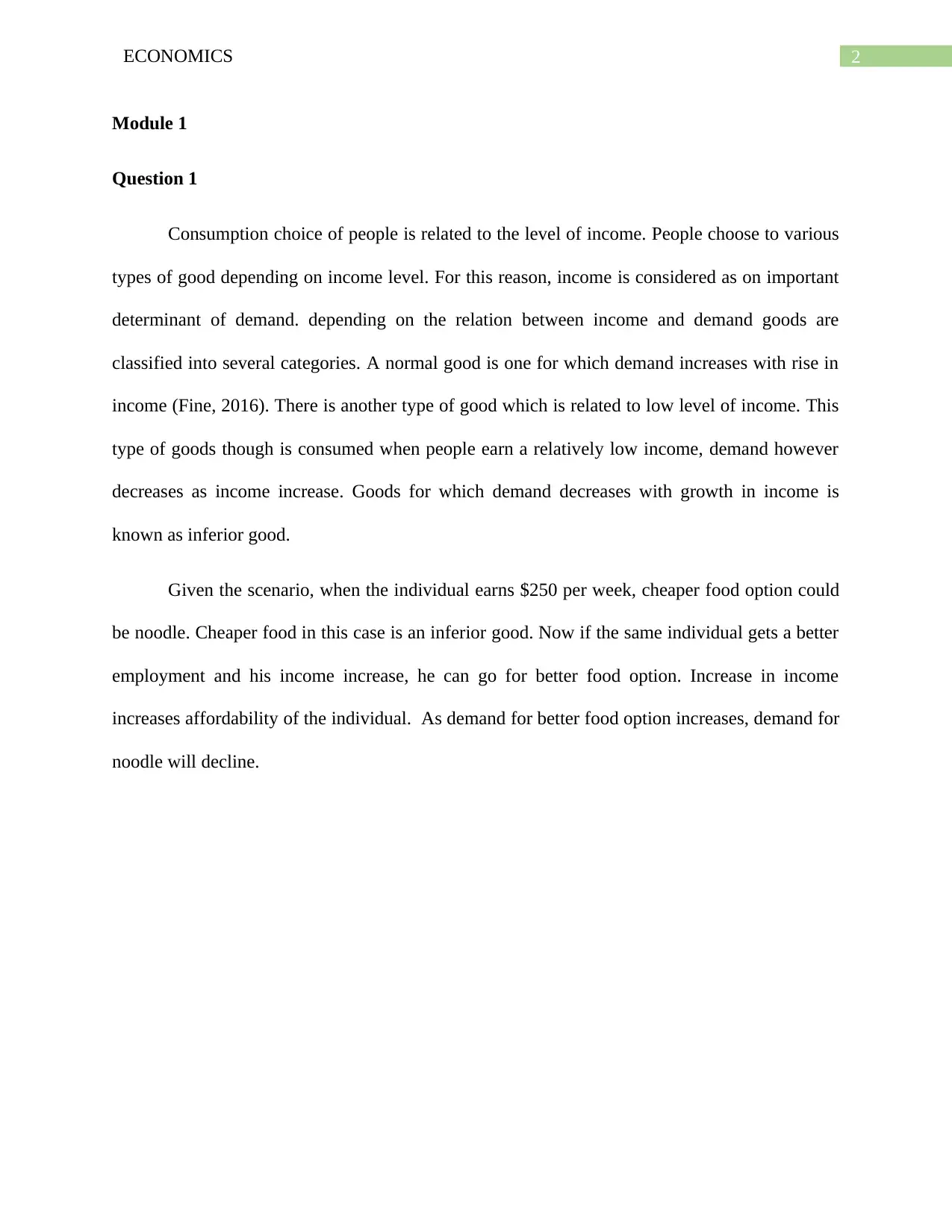
2ECONOMICS
Module 1
Question 1
Consumption choice of people is related to the level of income. People choose to various
types of good depending on income level. For this reason, income is considered as on important
determinant of demand. depending on the relation between income and demand goods are
classified into several categories. A normal good is one for which demand increases with rise in
income (Fine, 2016). There is another type of good which is related to low level of income. This
type of goods though is consumed when people earn a relatively low income, demand however
decreases as income increase. Goods for which demand decreases with growth in income is
known as inferior good.
Given the scenario, when the individual earns $250 per week, cheaper food option could
be noodle. Cheaper food in this case is an inferior good. Now if the same individual gets a better
employment and his income increase, he can go for better food option. Increase in income
increases affordability of the individual. As demand for better food option increases, demand for
noodle will decline.
Module 1
Question 1
Consumption choice of people is related to the level of income. People choose to various
types of good depending on income level. For this reason, income is considered as on important
determinant of demand. depending on the relation between income and demand goods are
classified into several categories. A normal good is one for which demand increases with rise in
income (Fine, 2016). There is another type of good which is related to low level of income. This
type of goods though is consumed when people earn a relatively low income, demand however
decreases as income increase. Goods for which demand decreases with growth in income is
known as inferior good.
Given the scenario, when the individual earns $250 per week, cheaper food option could
be noodle. Cheaper food in this case is an inferior good. Now if the same individual gets a better
employment and his income increase, he can go for better food option. Increase in income
increases affordability of the individual. As demand for better food option increases, demand for
noodle will decline.
⊘ This is a preview!⊘
Do you want full access?
Subscribe today to unlock all pages.

Trusted by 1+ million students worldwide
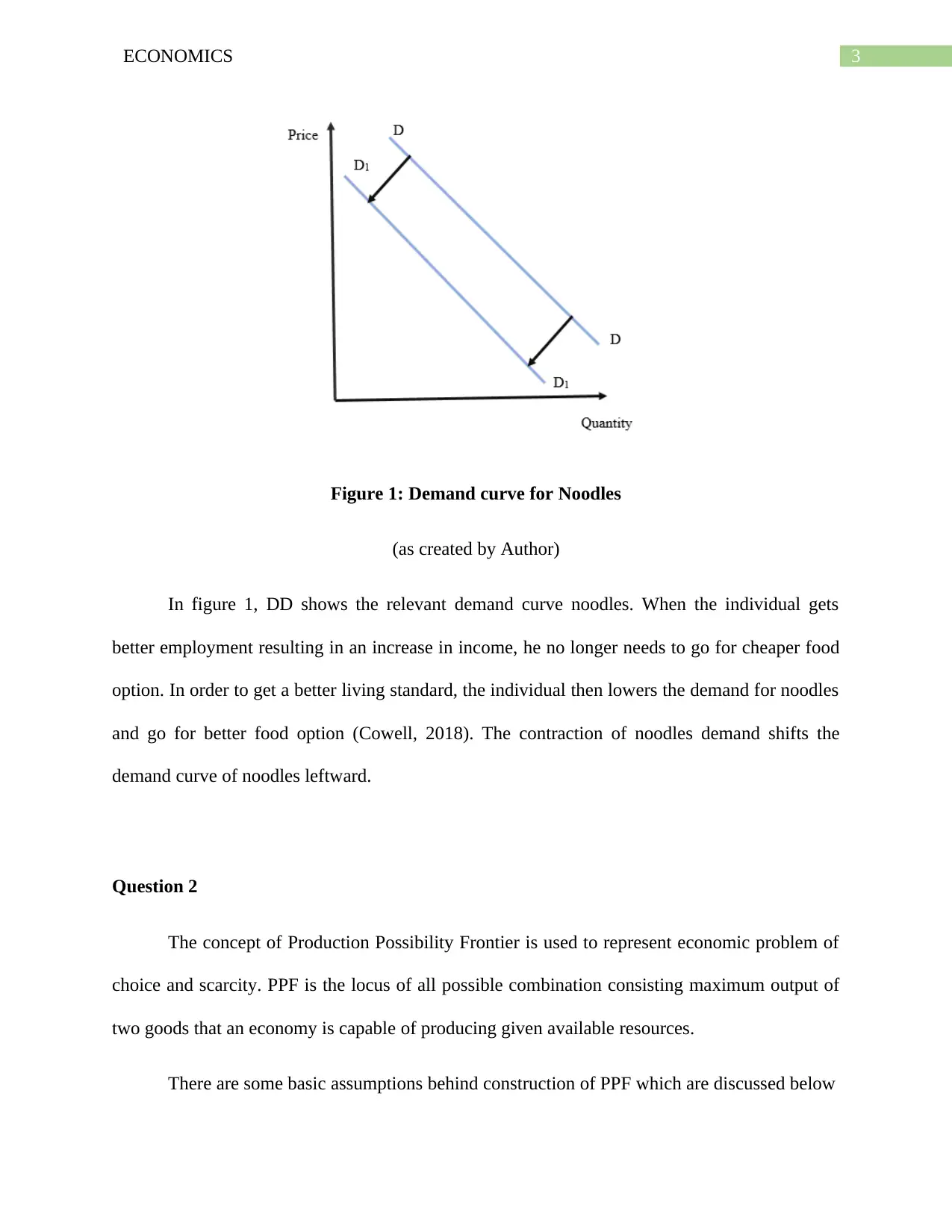
3ECONOMICS
Figure 1: Demand curve for Noodles
(as created by Author)
In figure 1, DD shows the relevant demand curve noodles. When the individual gets
better employment resulting in an increase in income, he no longer needs to go for cheaper food
option. In order to get a better living standard, the individual then lowers the demand for noodles
and go for better food option (Cowell, 2018). The contraction of noodles demand shifts the
demand curve of noodles leftward.
Question 2
The concept of Production Possibility Frontier is used to represent economic problem of
choice and scarcity. PPF is the locus of all possible combination consisting maximum output of
two goods that an economy is capable of producing given available resources.
There are some basic assumptions behind construction of PPF which are discussed below
Figure 1: Demand curve for Noodles
(as created by Author)
In figure 1, DD shows the relevant demand curve noodles. When the individual gets
better employment resulting in an increase in income, he no longer needs to go for cheaper food
option. In order to get a better living standard, the individual then lowers the demand for noodles
and go for better food option (Cowell, 2018). The contraction of noodles demand shifts the
demand curve of noodles leftward.
Question 2
The concept of Production Possibility Frontier is used to represent economic problem of
choice and scarcity. PPF is the locus of all possible combination consisting maximum output of
two goods that an economy is capable of producing given available resources.
There are some basic assumptions behind construction of PPF which are discussed below
Paraphrase This Document
Need a fresh take? Get an instant paraphrase of this document with our AI Paraphraser
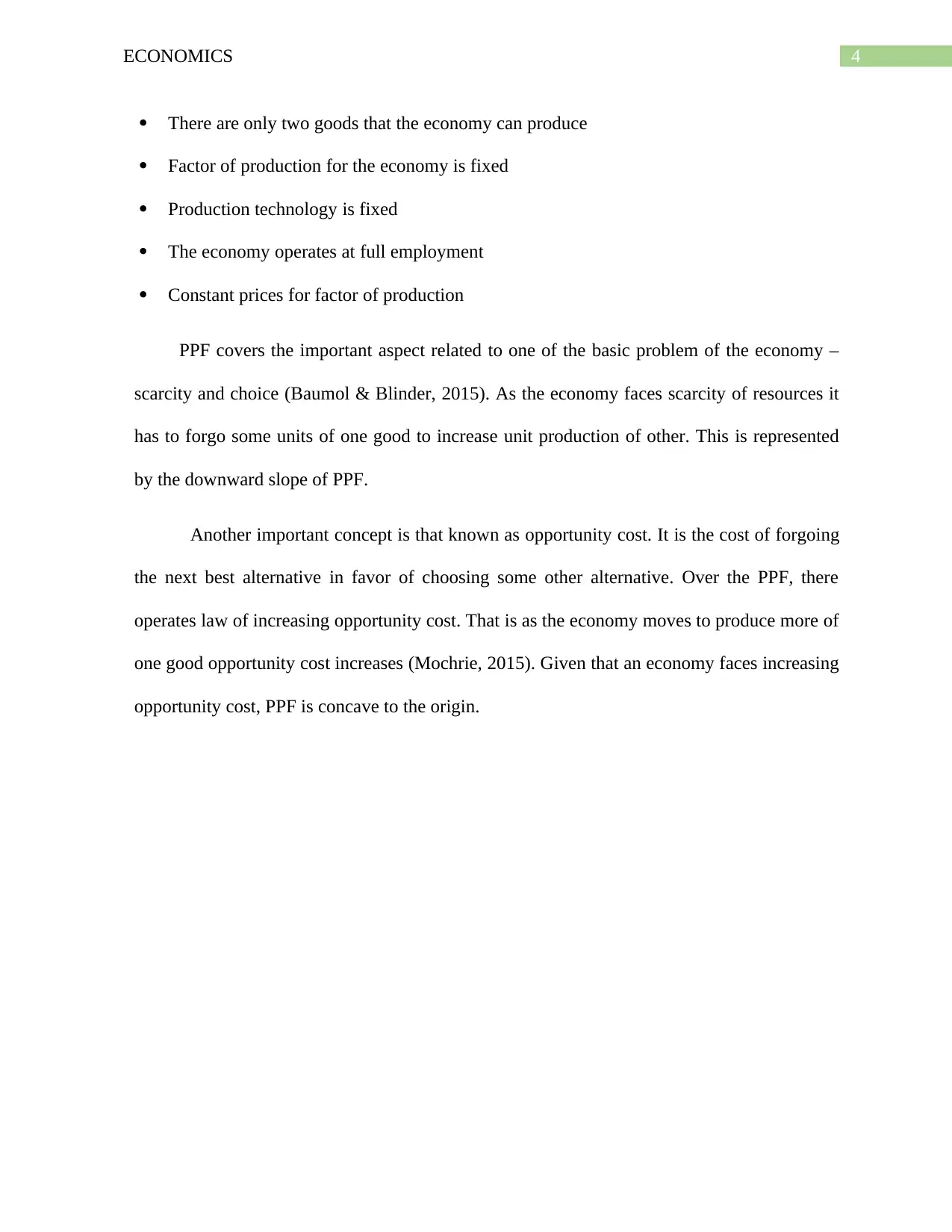
4ECONOMICS
There are only two goods that the economy can produce
Factor of production for the economy is fixed
Production technology is fixed
The economy operates at full employment
Constant prices for factor of production
PPF covers the important aspect related to one of the basic problem of the economy –
scarcity and choice (Baumol & Blinder, 2015). As the economy faces scarcity of resources it
has to forgo some units of one good to increase unit production of other. This is represented
by the downward slope of PPF.
Another important concept is that known as opportunity cost. It is the cost of forgoing
the next best alternative in favor of choosing some other alternative. Over the PPF, there
operates law of increasing opportunity cost. That is as the economy moves to produce more of
one good opportunity cost increases (Mochrie, 2015). Given that an economy faces increasing
opportunity cost, PPF is concave to the origin.
There are only two goods that the economy can produce
Factor of production for the economy is fixed
Production technology is fixed
The economy operates at full employment
Constant prices for factor of production
PPF covers the important aspect related to one of the basic problem of the economy –
scarcity and choice (Baumol & Blinder, 2015). As the economy faces scarcity of resources it
has to forgo some units of one good to increase unit production of other. This is represented
by the downward slope of PPF.
Another important concept is that known as opportunity cost. It is the cost of forgoing
the next best alternative in favor of choosing some other alternative. Over the PPF, there
operates law of increasing opportunity cost. That is as the economy moves to produce more of
one good opportunity cost increases (Mochrie, 2015). Given that an economy faces increasing
opportunity cost, PPF is concave to the origin.
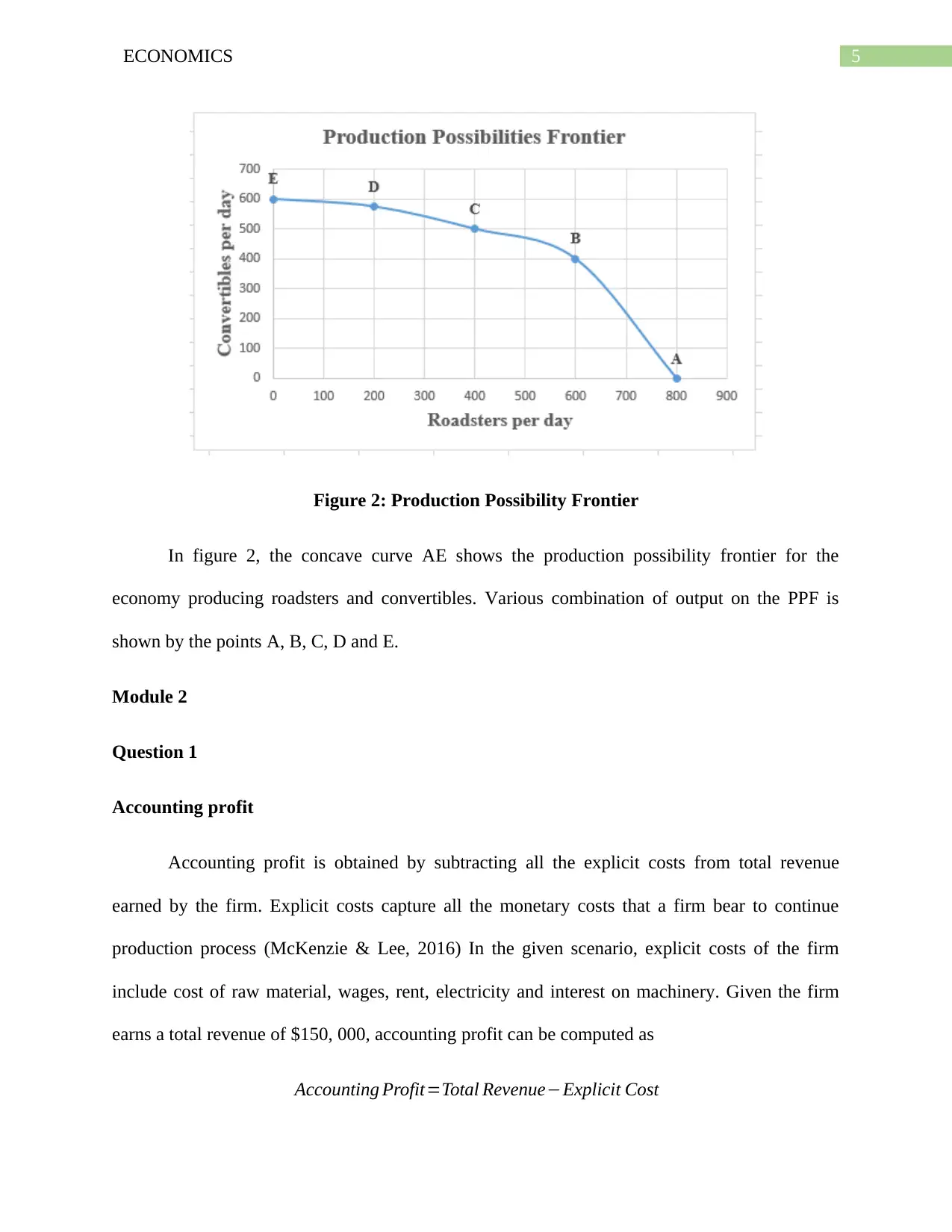
5ECONOMICS
Figure 2: Production Possibility Frontier
In figure 2, the concave curve AE shows the production possibility frontier for the
economy producing roadsters and convertibles. Various combination of output on the PPF is
shown by the points A, B, C, D and E.
Module 2
Question 1
Accounting profit
Accounting profit is obtained by subtracting all the explicit costs from total revenue
earned by the firm. Explicit costs capture all the monetary costs that a firm bear to continue
production process (McKenzie & Lee, 2016) In the given scenario, explicit costs of the firm
include cost of raw material, wages, rent, electricity and interest on machinery. Given the firm
earns a total revenue of $150, 000, accounting profit can be computed as
Accounting Profit=Total Revenue−Explicit Cost
Figure 2: Production Possibility Frontier
In figure 2, the concave curve AE shows the production possibility frontier for the
economy producing roadsters and convertibles. Various combination of output on the PPF is
shown by the points A, B, C, D and E.
Module 2
Question 1
Accounting profit
Accounting profit is obtained by subtracting all the explicit costs from total revenue
earned by the firm. Explicit costs capture all the monetary costs that a firm bear to continue
production process (McKenzie & Lee, 2016) In the given scenario, explicit costs of the firm
include cost of raw material, wages, rent, electricity and interest on machinery. Given the firm
earns a total revenue of $150, 000, accounting profit can be computed as
Accounting Profit=Total Revenue−Explicit Cost
⊘ This is a preview!⊘
Do you want full access?
Subscribe today to unlock all pages.

Trusted by 1+ million students worldwide
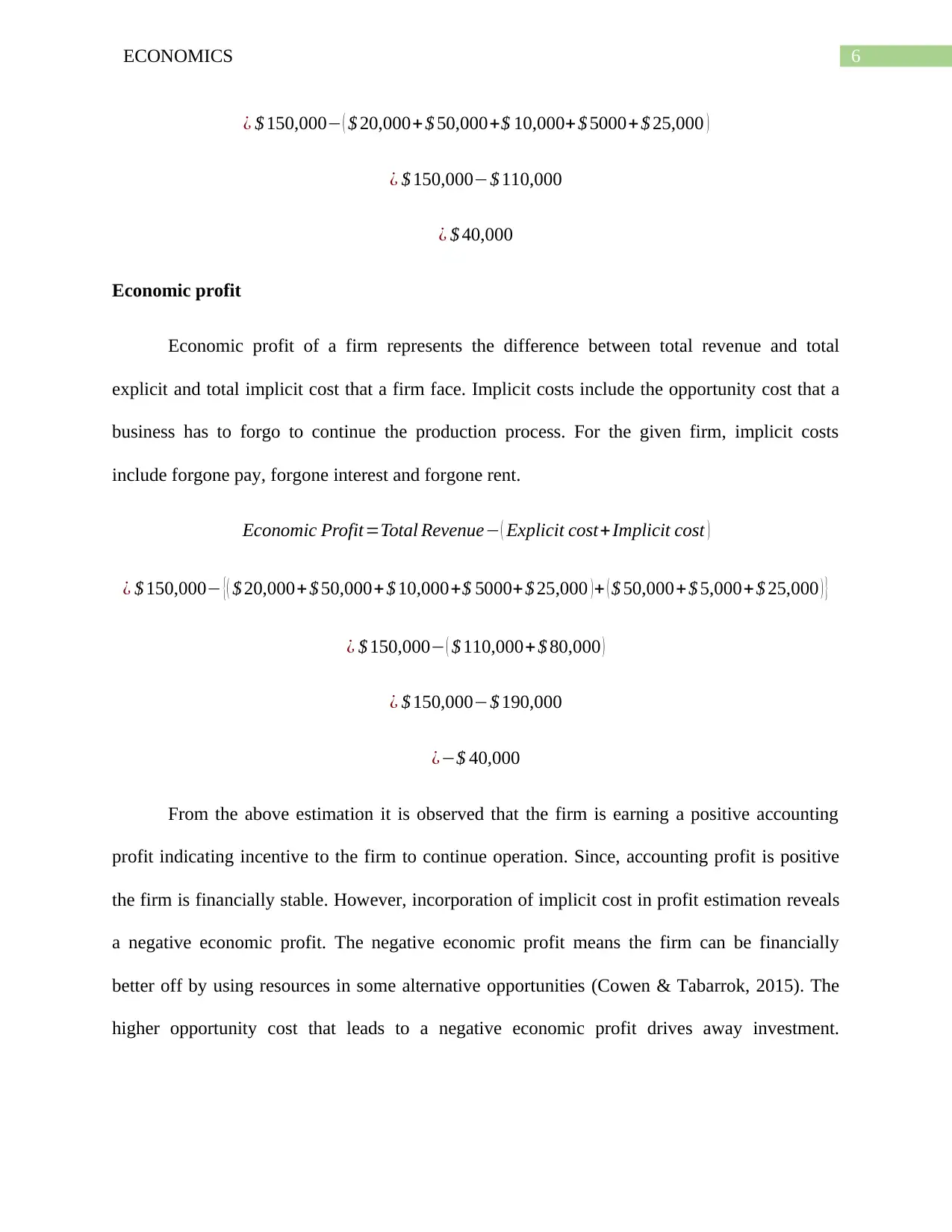
6ECONOMICS
¿ $ 150,000− ( $ 20,000+ $ 50,000+$ 10,000+ $ 5000+$ 25,000 )
¿ $ 150,000−$ 110,000
¿ $ 40,000
Economic profit
Economic profit of a firm represents the difference between total revenue and total
explicit and total implicit cost that a firm face. Implicit costs include the opportunity cost that a
business has to forgo to continue the production process. For the given firm, implicit costs
include forgone pay, forgone interest and forgone rent.
Economic Profit=Total Revenue− ( Explicit cost+Implicit cost )
¿ $ 150,000− {( $ 20,000+ $ 50,000+ $ 10,000+$ 5000+ $ 25,000 ) + ( $ 50,000+ $ 5,000+ $ 25,000 ) }
¿ $ 150,000− ( $ 110,000+ $ 80,000 )
¿ $ 150,000−$ 190,000
¿−$ 40,000
From the above estimation it is observed that the firm is earning a positive accounting
profit indicating incentive to the firm to continue operation. Since, accounting profit is positive
the firm is financially stable. However, incorporation of implicit cost in profit estimation reveals
a negative economic profit. The negative economic profit means the firm can be financially
better off by using resources in some alternative opportunities (Cowen & Tabarrok, 2015). The
higher opportunity cost that leads to a negative economic profit drives away investment.
¿ $ 150,000− ( $ 20,000+ $ 50,000+$ 10,000+ $ 5000+$ 25,000 )
¿ $ 150,000−$ 110,000
¿ $ 40,000
Economic profit
Economic profit of a firm represents the difference between total revenue and total
explicit and total implicit cost that a firm face. Implicit costs include the opportunity cost that a
business has to forgo to continue the production process. For the given firm, implicit costs
include forgone pay, forgone interest and forgone rent.
Economic Profit=Total Revenue− ( Explicit cost+Implicit cost )
¿ $ 150,000− {( $ 20,000+ $ 50,000+ $ 10,000+$ 5000+ $ 25,000 ) + ( $ 50,000+ $ 5,000+ $ 25,000 ) }
¿ $ 150,000− ( $ 110,000+ $ 80,000 )
¿ $ 150,000−$ 190,000
¿−$ 40,000
From the above estimation it is observed that the firm is earning a positive accounting
profit indicating incentive to the firm to continue operation. Since, accounting profit is positive
the firm is financially stable. However, incorporation of implicit cost in profit estimation reveals
a negative economic profit. The negative economic profit means the firm can be financially
better off by using resources in some alternative opportunities (Cowen & Tabarrok, 2015). The
higher opportunity cost that leads to a negative economic profit drives away investment.
Paraphrase This Document
Need a fresh take? Get an instant paraphrase of this document with our AI Paraphraser
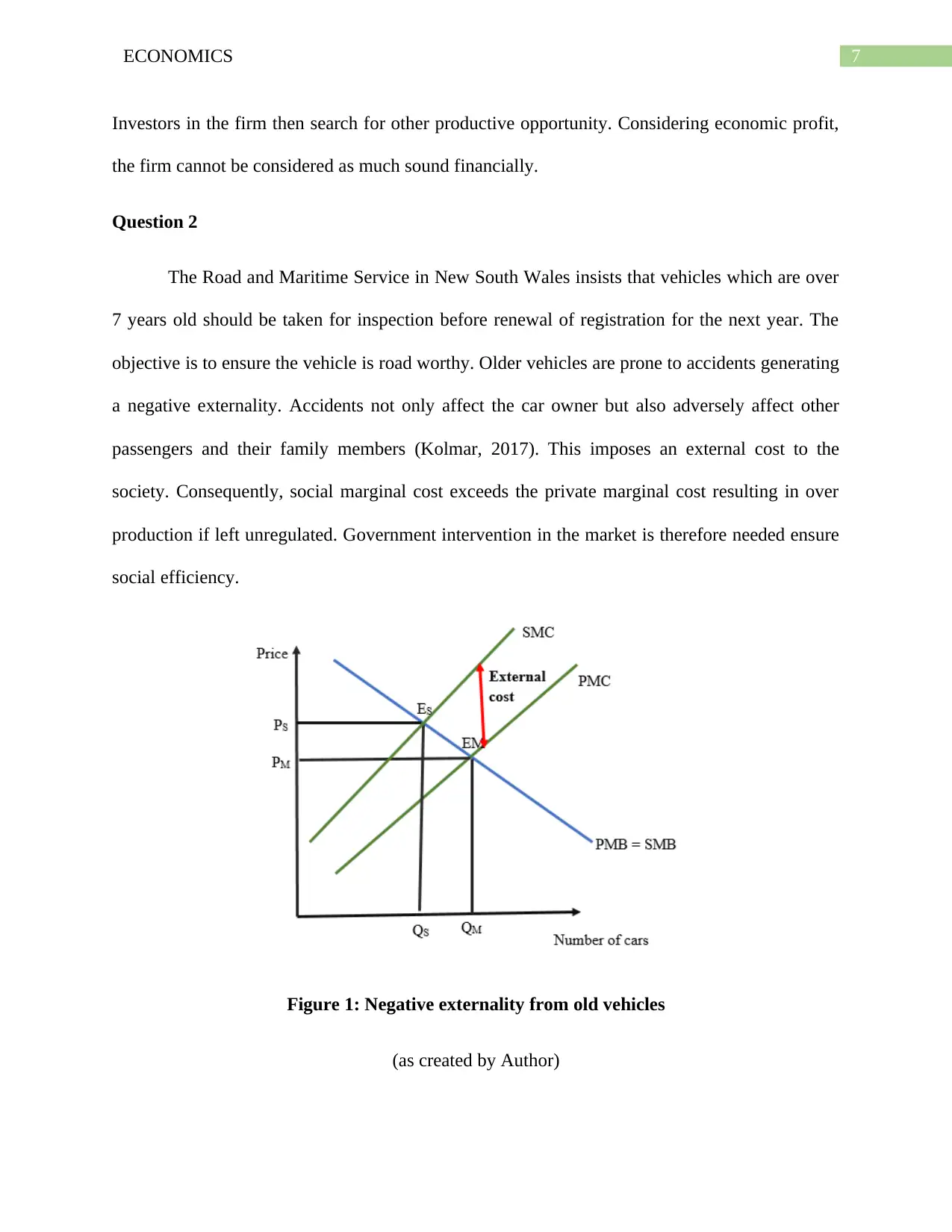
7ECONOMICS
Investors in the firm then search for other productive opportunity. Considering economic profit,
the firm cannot be considered as much sound financially.
Question 2
The Road and Maritime Service in New South Wales insists that vehicles which are over
7 years old should be taken for inspection before renewal of registration for the next year. The
objective is to ensure the vehicle is road worthy. Older vehicles are prone to accidents generating
a negative externality. Accidents not only affect the car owner but also adversely affect other
passengers and their family members (Kolmar, 2017). This imposes an external cost to the
society. Consequently, social marginal cost exceeds the private marginal cost resulting in over
production if left unregulated. Government intervention in the market is therefore needed ensure
social efficiency.
Figure 1: Negative externality from old vehicles
(as created by Author)
Investors in the firm then search for other productive opportunity. Considering economic profit,
the firm cannot be considered as much sound financially.
Question 2
The Road and Maritime Service in New South Wales insists that vehicles which are over
7 years old should be taken for inspection before renewal of registration for the next year. The
objective is to ensure the vehicle is road worthy. Older vehicles are prone to accidents generating
a negative externality. Accidents not only affect the car owner but also adversely affect other
passengers and their family members (Kolmar, 2017). This imposes an external cost to the
society. Consequently, social marginal cost exceeds the private marginal cost resulting in over
production if left unregulated. Government intervention in the market is therefore needed ensure
social efficiency.
Figure 1: Negative externality from old vehicles
(as created by Author)

8ECONOMICS
The above figure explains negative externality associated with old vehicles. PMC curve
shows the private marginal cost. The older vehicles are not worthy for roads. As probability of
accident is larger with older cars the society faces an external cost because of use of this
vehicles, the social marginal cost is above the private marginal cost. Free market equilibrium is
at EM, corresponding price and output being PM and QM respectively. The socially optimal
equilibrium however is at ES. Quantity and price of older cars associated to the socially optimal
equilibrium is QS and PS respectively (Pindyck & Rubinfeld, 2015) Therefore, by insisting
inspection for cars older 7 years helps to internalize the externality yielding socially efficient
outcome.
The above figure explains negative externality associated with old vehicles. PMC curve
shows the private marginal cost. The older vehicles are not worthy for roads. As probability of
accident is larger with older cars the society faces an external cost because of use of this
vehicles, the social marginal cost is above the private marginal cost. Free market equilibrium is
at EM, corresponding price and output being PM and QM respectively. The socially optimal
equilibrium however is at ES. Quantity and price of older cars associated to the socially optimal
equilibrium is QS and PS respectively (Pindyck & Rubinfeld, 2015) Therefore, by insisting
inspection for cars older 7 years helps to internalize the externality yielding socially efficient
outcome.
⊘ This is a preview!⊘
Do you want full access?
Subscribe today to unlock all pages.

Trusted by 1+ million students worldwide
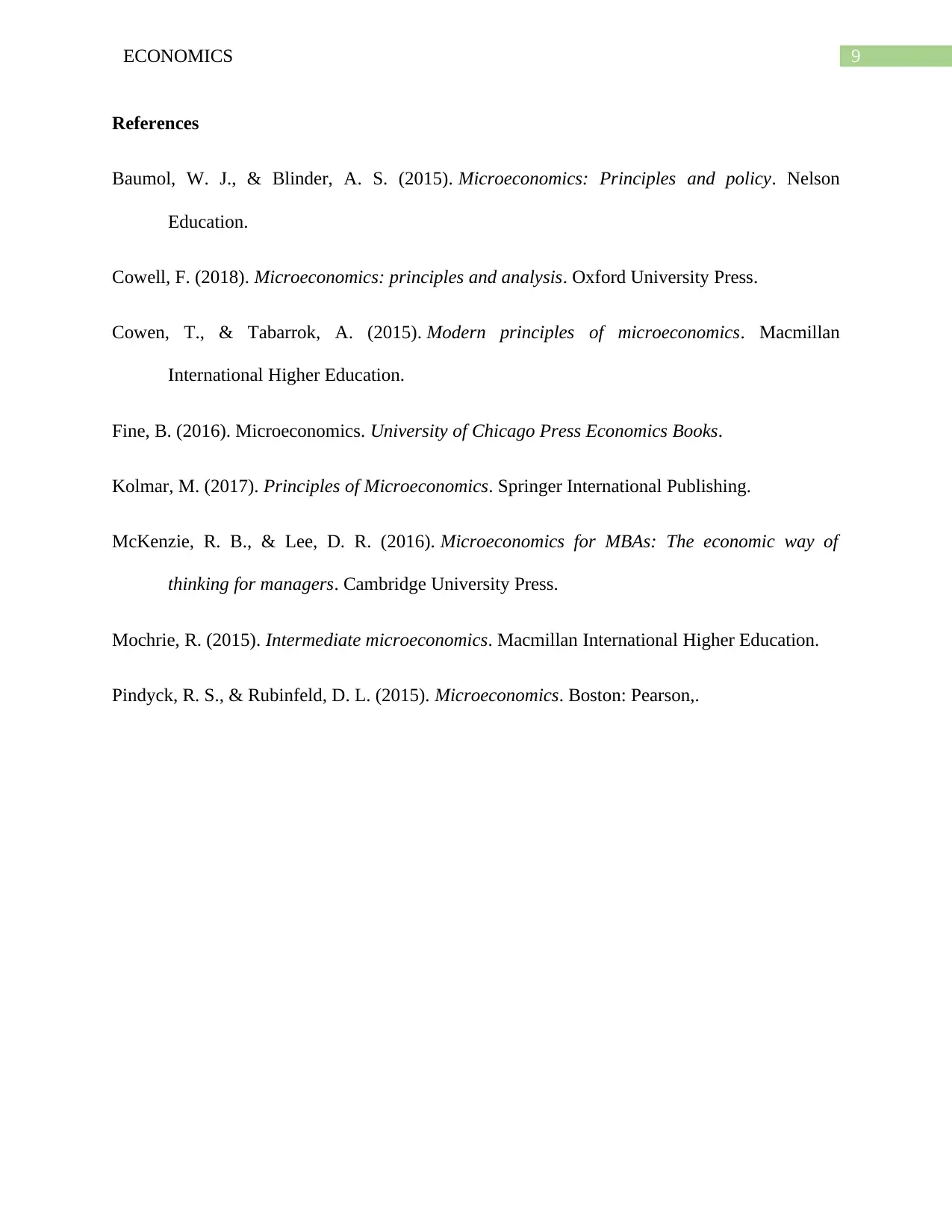
9ECONOMICS
References
Baumol, W. J., & Blinder, A. S. (2015). Microeconomics: Principles and policy. Nelson
Education.
Cowell, F. (2018). Microeconomics: principles and analysis. Oxford University Press.
Cowen, T., & Tabarrok, A. (2015). Modern principles of microeconomics. Macmillan
International Higher Education.
Fine, B. (2016). Microeconomics. University of Chicago Press Economics Books.
Kolmar, M. (2017). Principles of Microeconomics. Springer International Publishing.
McKenzie, R. B., & Lee, D. R. (2016). Microeconomics for MBAs: The economic way of
thinking for managers. Cambridge University Press.
Mochrie, R. (2015). Intermediate microeconomics. Macmillan International Higher Education.
Pindyck, R. S., & Rubinfeld, D. L. (2015). Microeconomics. Boston: Pearson,.
References
Baumol, W. J., & Blinder, A. S. (2015). Microeconomics: Principles and policy. Nelson
Education.
Cowell, F. (2018). Microeconomics: principles and analysis. Oxford University Press.
Cowen, T., & Tabarrok, A. (2015). Modern principles of microeconomics. Macmillan
International Higher Education.
Fine, B. (2016). Microeconomics. University of Chicago Press Economics Books.
Kolmar, M. (2017). Principles of Microeconomics. Springer International Publishing.
McKenzie, R. B., & Lee, D. R. (2016). Microeconomics for MBAs: The economic way of
thinking for managers. Cambridge University Press.
Mochrie, R. (2015). Intermediate microeconomics. Macmillan International Higher Education.
Pindyck, R. S., & Rubinfeld, D. L. (2015). Microeconomics. Boston: Pearson,.
1 out of 10
Related Documents
Your All-in-One AI-Powered Toolkit for Academic Success.
+13062052269
info@desklib.com
Available 24*7 on WhatsApp / Email
![[object Object]](/_next/static/media/star-bottom.7253800d.svg)
Unlock your academic potential
Copyright © 2020–2025 A2Z Services. All Rights Reserved. Developed and managed by ZUCOL.





